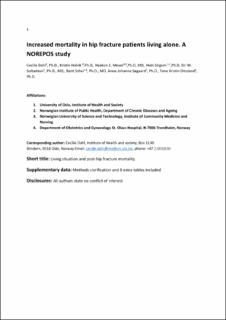| dc.description.abstract | Hip fracture is associated with excess mortality, persisting for many years after the fracture. Several factors may affect survival; however, the role of social support has been less studied. Living situation could be an indicator of a person's social support, which predicts mortality in the general population. In this longitudinal cohort study, we considered whether living alone was a risk factor for post‐hip fracture mortality compared with living with a partner. Information on hip fractures from all hospitals in Norway from 2002 to 2013 was combined with the 2001 National Population and Housing Census. The association between living situation and mortality during 12.8 years of follow‐up in 12,770 men and 22,067 women aged 50 to 79 years at fracture was investigated using flexible parametric survival analysis. We also estimated relative survival of hip fracture patients compared with that of the non‐fractured background population in the same living situation (alone or with a partner). Higher mortality after hip fracture was found in both men and women living alone versus with a partner (hazard ratio [HR] men = 1.37, 95% confidence interval [CI] 1.29—1.44; HR women = 1.23, 95% CI 1.18—1.28, adjusting for age, education level, urbanization degree, and number of children). We demonstrated the strongest association in male hip fracture patients aged <60 years (long‐term mortality HR = 3.29, 95% CI 2.25—6.49). Compared with the general population, relative survival 8 years after a hip fracture was 43% in men and 61% in women living alone, whereas relative survival in those living with a partner was 51% in men and 67% in women. In conclusion, hip fracture patients who lived alone had higher mortality than those living with a partner and lower survival relative to the general population. © 2021 American Society for Bone and Mineral Research (ASBMR). | en_US |
